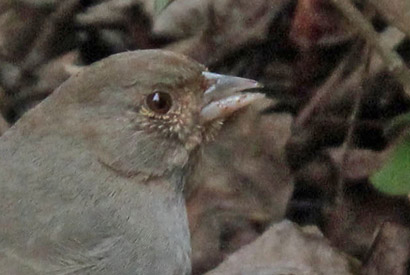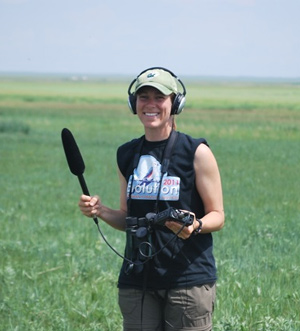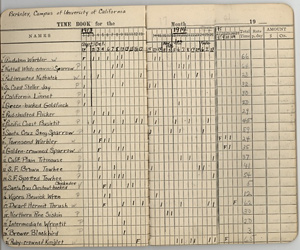Campus still a great place for birds despite century of changes
The bird population on the Berkeley campus has remained surprisingly diverse over the past 100 years, showing that it’s possible to create a green wildlife haven within a dense urban area, researchers say.

July 23, 2012
The bird population on the University of California, Berkeley, campus has remained surprisingly diverse over the past 100 years, showing that it’s possible to create a green wildlife haven within a dense urban area, researchers say.
The good news comes from a survey conducted over a six-month period covering the winter of 2006-07, newly published in the May 2012 issue of the journal The Condor. The study, conducted during the non-breeding season, identified 48 separate bird species in an 84-acre portion of the 178-acre central campus. That’s a greater number of species than the 44 and 46 recorded during surveys conducted in 1913-18 and 1938-39, respectively.
“The presumption going in was that we would see a steady decline in the number of species because the campus, like any urban environment, has been heavily modified, with more buildings and 15 times more students,” said Rauri Bowie, UC Berkeley professor of integrative biology. “But despite everything that has happened on campus in the past century, we find absolutely no evidence for that.”
Nevertheless, “the composition — which birds were around — actually changed pretty substantially over the past 93 years, conforming fairly well to the campus landscape at the time,” said Allison Shultz, a former UC Berkeley student who conducted the survey for her honors thesis.
In 1913, the campus was an oak woodland that was interspersed with grassland and shrubby chaparral and dissected by Strawberry Creek and its forks. Song, White-Crowned and Golden-Crowned Sparrows, as well as Wrentits, were common in the brush, as were grassland species like the Western Meadowlark.
Today, these birds are rare. While the oaks have been preserved and Strawberry Creek restored to a native riparian habitat, the tall grasses and chaparral have been replaced by lawns and ornamental shrubs, an environment favored by species such as the Lesser Goldfinch, Nuttall’s Woodpecker and the Chestnut-Backed Chickadee.

Allison Shultz in the field in Mongolia. Photo courtesy of Scott Edwards.
Crows and ravens have also increased greatly, as they have across the nation, Shultz said. She saw a similar increase in other species that adapt well to human habitats: the Ring-Billed Gull, hawks and Mourning Doves, for example. A pair of Cooper’s Hawks has nested in the campus’s eucalyptus grove for nearly 10 years, while Red-Shouldered and Red-Tailed Hawks are common.
“These birds are really good at exploiting the refuse associated with humanity; they’re very adaptable and smart, quickly learning the routines people develop, and they’re good at surviving in a wide variety of environments,” Bowie said.
Overall, the findings make Bowie and Shultz optimistic about the ability of urban green spaces, and college campuses in particular, to serve as islands of diversity.
“It is time for urban green spaces to be thought of not only as hospices for diversity, but also as potential nurseries,” the researchers wrote in their paper.
Campus landscape architect Jim Horner was pleased to hear about the healthy bird population, but noted that he can’t take the credit.
“It’s fun to see that birds are still flocking to campus despite all we’ve built here over time, but it’s a happy accident,” he said. “Long-term efforts to keep the campus vegetatively diverse, including setting aside natural areas and open space, benefit all populations.”
Dusty files turn out to be gold mine
Shultz had only a passing interest in birds until, as a junior, she took a legendary course, the Natural History of Vertebrates, which has been taught since 1901 and set many a student on a career path in biology. With 13 field trips, the class is intensive, but Shultz said “it definitely changed my life.” She graduated with a bachelor’s in integrative biology in 2007 and is now a graduate student in evolutionary biology at Harvard University, having recently returned from a bird survey trip to Mongolia.
During her junior and senior years, Shultz participated in the Grinnell Resurvey of California wildlife conducted by the campus’s Museum of Vertebrate Zoology, dug up the two previous bird surveys and decided to repeat them.
One survey was conducted by a museum researcher and one of the campus’s earliest female scientists, Margaret Wythe, over a five-year period between 1913 and 1918. The other study was conducted by two graduate students, Thomas L. Rodgers and Charles G. Sibley, from 1938 to 1939, and was later published in The Condor. Sibley went on to become one of the country’s most prominent ornithologists. He co-authored Phylogeny and Classification of the Birds and Distribution and Taxonomy of Birds of the World, considered the bibles of bird classification, and was among the first to use DNA to establish avian relationships, Bowie said.
Shultz adopted Sibley and Rodgers’ study design and laid out three similar routes through the western part of the campus, which she traversed 10 times per month between October and March, randomly choosing a route in the morning, at noon and in the evening. She spent about three hours per day for 60 days surveying campus birds.
“I definitely got some strange looks, standing there with my binoculars, rangefinder and clipboard, recording things, but I think Berkeley people are used to seeing weird stuff around the campus,” Shultz said.

Pages from the log of campus birds kept by Museum of Vertebrate Zoology researcher Margaret Wythe in 1913 and 1914. Some of the names of the birds have changed since then. Photo by Allison Shultz.
With data covering a 93-year period, Shultz and Bowie were able to make comparisons across time that are rare, Bowie said, since few researchers nearly a century ago took sufficiently detailed notes. The notes from both surveys were so specific that Shultz and Bowie were able to perfectly replicate the routes covered on campus. That was a legacy of zoologist Joseph Grinnell, museum director and field biologist extraordinaire, whose method of precise observation and annotation, the Grinnellian System, was adopted by Wythe, Rodgers, Sibley and many of today’s field biologists.
“With studies like these, the data often don’t survive,” Bowie said. “But Wythe’s data were squirreled away in the dusty drawers of the campus’s Museum of Vertebrate Zoology, and we were able to pull it out. We need more people to look for old and dusty data files; they can tell us a lot.”
The pluses of restoring native habitat
Bowie said that biologists expect urbanization to either decrease the diversity of species; homogenize species, such that the same bird species are found in cities regardless of location; or lead to community turnover, so that a diverse but different group of species comes in more suited to a different habitat.
“We found evidence that if you still have a lot of open space, as in the suburbs or on campus, you tend to get community turnover,” Bowie said. “Very sensitive species disappear, but other species come in to fill similar functional roles. You get different seed eaters and different fruit eaters, for example, with no decrease in net diversity.”
Because the earlier studies looked only at the presence or absence of species, the recent study only analyzed changes in the number of bird species. But Shultz also counted the relative abundance of different bird species, filing her data for some future undergraduate who will be able to write her honor’s thesis on how the numbers as well as variety of birds on campus have changed with time.
Morgan Tingley, a post-doctoral fellow at Princeton University and former Ph.D. student in UC Berkeley’s Department of Environmental Science, Policy and Management and at the Museum of Vertebrate Zoology, also co-authored the paper.
Shultz’s work was supported in part by a National Science Foundation Graduate Research Fellowship.
RELATED INFORMATION